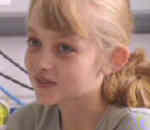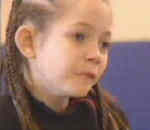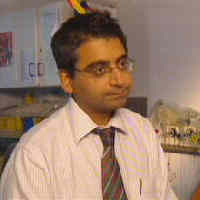Cystic Fibrosis
Will I Still Love My Mum?

Hannah

Kayley
A Monumental Decision
Hannah Whitten and Kayley Keir are two ten year old girls who both suffer from cystic fibrosis.
CF is the UK’s most common life-threatening, inherited disease. It affects the vital organs, particularly the lungs and digestive system, clogging them with a sticky mucus making it difficult to breathe or digest food.
Both Hannah and Kayley will soon be faced with a life-or-death decision. Their health will deteriorate to a point where they will need a heart and lung transplant to survive. But a transplant is a high risk operation which could kill them. But, the final decision to proceed with a transplant will be theirs and theirs alone.
Dr. Andy Bush of the Royal Brompton Hospital says of cystic fibrosis: "There have been enormous advances in treatment. In the 1930’s when it was first described, virtually everybody with CF was dead before they were a year old. Now, average survival is 40 years. The oldest person I know with cystic fibrosis is 86 years old. There is huge progress but, CF is still not a curable disease."
Kayley is the first to be considered for a transplant and she travels to Great Ormond Street Children’s Hospital in London with her mother for a series of physical tests to assess her suitability for a transplant. Hospital staff are not convinced that Kayley’s condition is severe enough to warrant the risk of transplant and they ask to see her again in a few months time.
Cystic Fibrosis is a genetic condition, and one in five people carry the defective gene. If both parents carry the defective gene then there is a 1 in 4 chance the child will have CF.
Each child with cystic fibrosis must undergo rigorous physiotherapy, twice a day, every day. The back and sides are beaten rhythmically to loosen the mucus and try to clear the lungs.
Kayley has already made her decision regarding the transplant and she will go on the waiting list if she can. Hannah, on the other hand, is terrified by the thought of the operation, and amongst her fears about a heart transplant she asks: "Will I still love my Mum?". She is assured that her feelings for her mum will be unchanged.
Hannah spends much of her time in hospital receiving repeated courses of antibiotics to fight off what would be minor chest infections in other children but could kill a child with CF.

Dr. Paul Aurora
One year after Kayley and her mum first came to Great Ormond Street Children’s Hospital the decision is finally made to put her on the transplant waiting list. Hannah’s parents think she should also go on the waiting list, but doctors won’t put her on the list on the word of the parents alone.
After another period of exhausting tests Hannah finally makes her decision. Despite all her trepidation she finds the courage to agree to be put forward for a transplant. Both she and Kayley are now involved in a terrible lottery. They never know when, or even if, the call will come to say that donor organs are available.
In December 2004, Hannah’s family receive the call and they are rushed to Great Ormond Street Children’s Hospital to prepare for the transplant. This is not the first call they have had, there was an earlier call that couldn’t process as the donor organs were not a sufficiently good match. Hannah is still terrified and a last moment panic attack nearly halts the surgery. Fortunately she calms down and the doctors are able to go ahead. The surgery is a success but no-one can be certain what the future may hold for this little girl.
Hannah and Kayley happen to be in Gt. Ormond Street at the same time during February 2005. This allows them to meet for the first time and let’s Kayley ask Hannah about her transplant. On top of her normal CF medication, Hannah now has to take 40 anti-rejection drugs every day, and will continue to do so for the rest of her life.
Hannah was fortunate, she received her transplant 3 months after going on the waiting list. Kayley has been on the list for 6 months with no sign of a suitable donor. Her small stature and blood group mean that there will be fewer donors that may be suitable.

